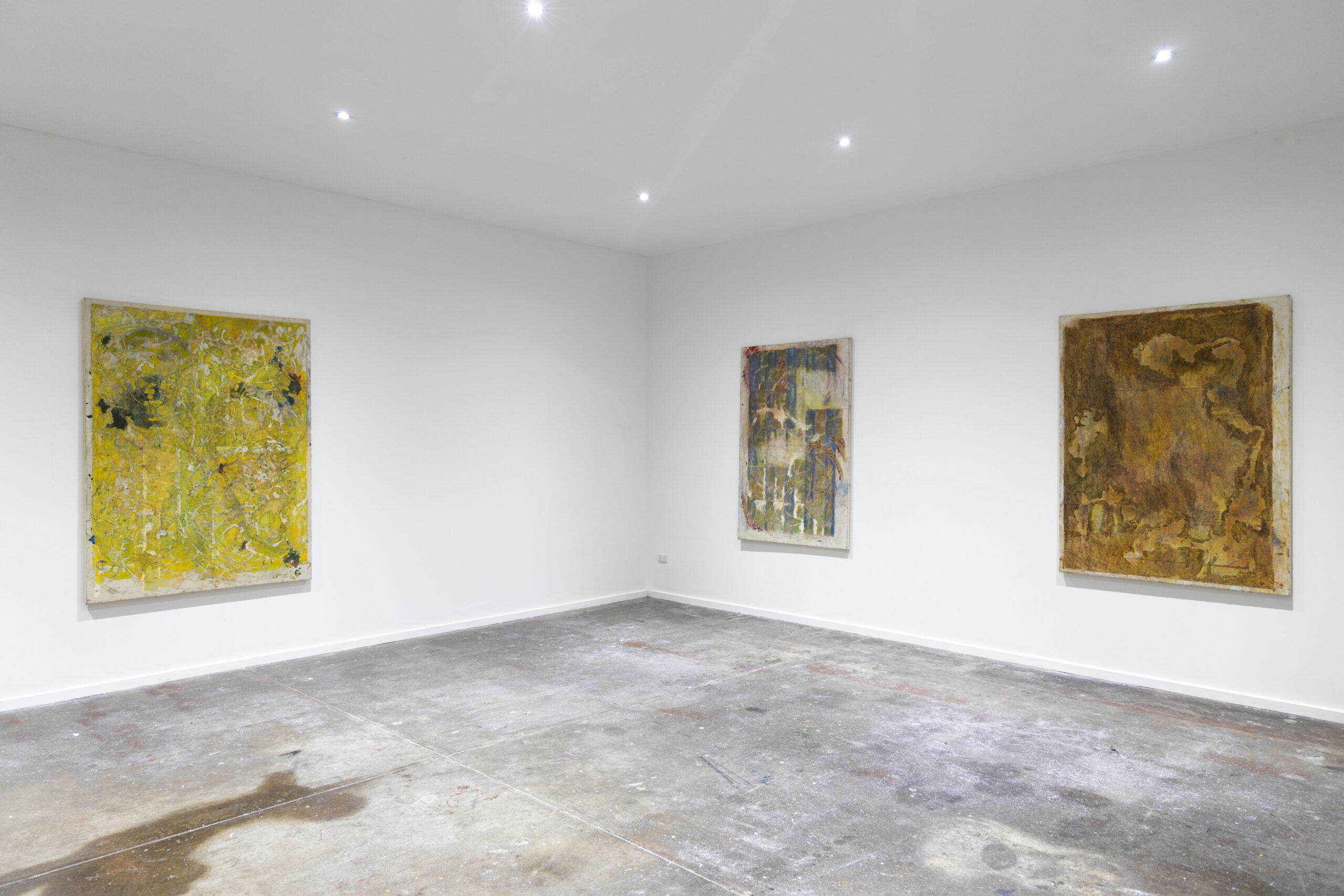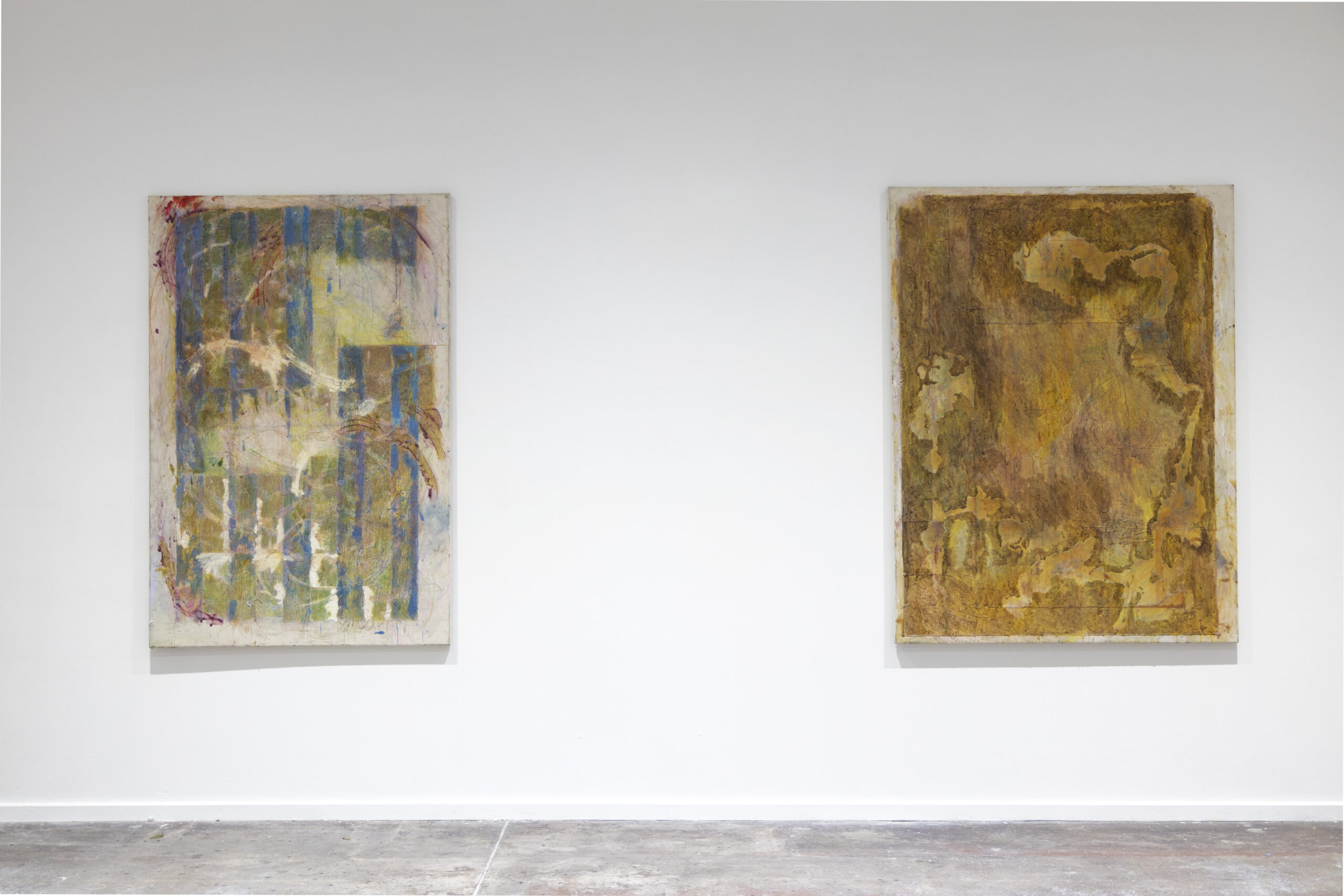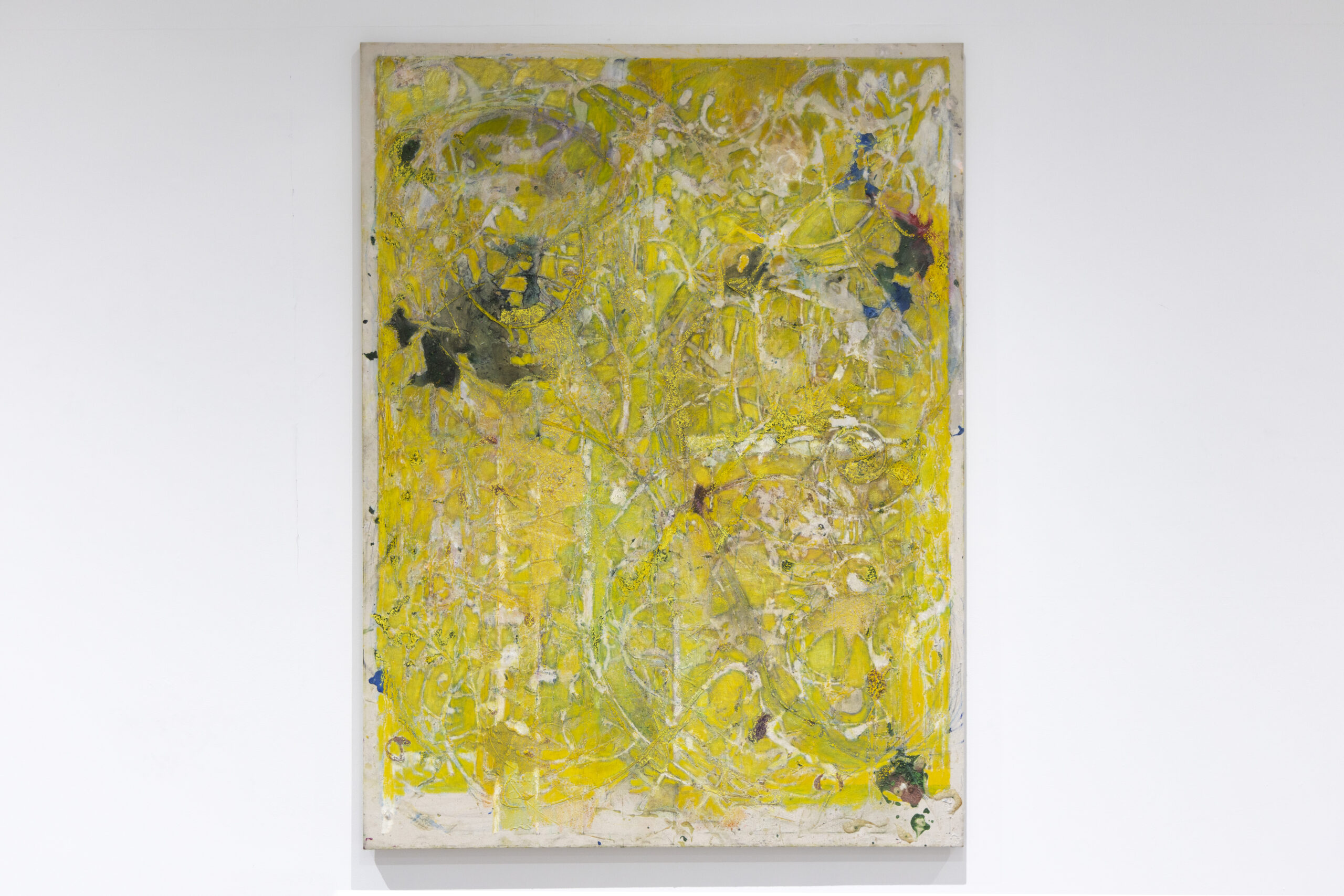Caesar Florence-Howard
27 May - 17 June
Earnest pastiche. It seems like a paradox. And yet the paintings in Caesar Florence-Howard’s self-titled exhibition opening at Sutton Projects last week seem to have drawn these terms into a new formal economy. The exhibition consists of three accumulative, large-scale paintings on canvas. The three paintings, all Untitled, have been produced over the three months since his graduating from the Honours program at Monash University. His work at the grad show won Florence-Howard the Irene Sutton Award, and this current offering is his acquittal.
Florence-Howard’s prior catalogue of work has been distinct and largely recognisable for the thick, coagulated shapes produced through his extended layering process. Seemingly messy Smithson-esque snail trails of sand and latex traipse across the canvas, ballooning out into thick masses of tactile gradients. Whilst remaining faithful to his painterly process, the organic forms and textures of these recent works have been overlaid with a subtle rectilinear geometry which signals a development in Florence-Howard’s practice since his graduating body of work in 2022.

The centrepiece of the Untitled troika seems to represent this drift towards the grid most clearly. When the Whitlam government purchased Jackson Pollock’s Blue Poles for the exorbitant price of two million dollars in 1973, they were met with fierce criticism from many quarters. Indeed, Pollock’s greatest critical proponent Clement Greenberg had, by the time Pollock painted Blue Poles, already decided that his signature gestures had become overworked. The result was their dissolution into hackneyed mannerisms with an almost figurative quality that betrayed the raison d’être of Abstract Expressionism. For local avant-gardists such as Ian Burn the purchase represented America’s growing cultural encroachment on the Antipodes. Many were simply bewildered by the abstruse opacity of Blue Poles. Robert Hughes has noted in The Shock of the New that as the work toured the country many punters recalled being able to make out AFL goalposts in their desperate search for precisely the figurative meaning Greenberg had marked as the picture’s failure. In Florence-Howard’s rendition, the blue poles have been produced by combining acrylic paint, glue and sand. The Australian Creep. The tension between the five columns, which attempt to structure the work whilst fighting against the decaying scribbles, smears and textures of play and abstraction, provides the clearest expression of what I take to be the structuring paradox of this exhibition.
This paradox stems in large part from the equal influence of the Jungen Wilden group on Florence-Howard’s painting. These artists like Martin Kippenberger, Albert Oehlen and Werner Buttner gathered around Cologne in the decades following the zenith of American Action Painting to express their antipathy towards romanticised ideals of the artist-as-oracle or shaman, which Buttner memorably parodied as the naivety of ‘immersing yourself in what there is and letting it rub off on the canvas’. Their rebuttals were prosecuted in a rough neo-expressionist late modernism, becoming more abstract after 1988. Later works by Albert Oehlen in particular, which combined blowsy abstraction, crude figuration and an allergy to composition have been influential in popularising a motion of “bad painting” for a generation of artists, not least in Melbourne.
But like a good abstract painter Florence-Howard’s process involves long stints in the studio. Often just waiting around, listening to music, drinking coffee. Then, when seized by a gust of inspiration, he’ll work on numerous canvases at once. It is inevitably messy, the canvases stink, they bleed into one another. But the result is not the kind of piled “bad painting” Oehlen popularised. Indeed in their balanced compositions and layered colour schemes, Florence-Howard seems to harness that ‘unstudied studiedness’ Greenberg declared integral to the success of Action Painting. Even the raw canvas borders that Florence-Howard incorporates into his work echoes Greenberg’s preference for paintings that ‘sit behind the canvas’. So although the Cologne tradition certainly casts a shadow over Florence-Howard’s show — all three Untitled paintings do rib and ironize those classic symbols and actions of the self-assured abstract expressionist ego — the paintings in Florence-Howard’s show seem to refract the Cologne school critique of the artist-as-oracle into a self-conscious extension of the abstract gestural form. This is a version of painterly pastiche which in its variation in hue and texture seems as earnestly committed to rehabilitating the ambitions of mid-century painting (not to mention those of precursors like J.M.W Turner) as it is in critiquing them.

The pour, the drip, smearing, swiping, scrubbing, scumbling. We can see them all in this body of work. We come face-to-face with those deep gradations of light and dark, those subterranean swirls which firstly supplanted classical chiaroscuro and then synthetic cubism. Then, we look a little closer. The off-white drips which snake and dazzle across the Untitled to the left of the room are actually paths of negative residue where the artist has applied wet latex and then ripped off its hardened shell. The rotten amber contours of the painting on the far right. Layers which make it look like a spread and flattened anthropological amoeba suspended in amber, recall de Kooning’s scumbled brushwork. But the list of materials betrays this reading: oil pastel, pencil, ink markers, latex. This is an abstract painting made without paint. An irony that is heightened by the rectilinear lines — phantom stretcher bars — that cut vertically across the picture plane to mark the top and bottom thirds of the painting.
Through canny formal manipulation Florence-Howard’s homage to those loaded gestures of painterliness actually empties them systemically, ironising the gestural tradition whilst simultaneously instrumentalising its legacy. That is to say, the pastiche of these paintings is not exactly, like “bad painting”, a parody of the artist-as-oracle, a joke on his professed ability to represent the unpresentable. Rather, in its aestheticisation of this parodic intervention as a non-didactic painterly method, Florence-Howard has fused a tradition of mid-twentieth century painting with its subsequent discontents. The result of earnest pastiche is something we might, in homage to Oehelen (and with emphasis on its scare quotes), call “good painting”.

Caesar Florence Howard’s immediate appearance as large-scale divine impetuosities reveal a methodological interrogation of abstract painting’s palimpsestic afterlife. The exhibition catalogue spruiks the artist's combination of traditional painterly material with non-orthodox elements like sand, latex and glue. There has indeed been a wave of paintings produced in Melbourne which employ a non-orthodox approach to materiality (trash, blood, coca cola, motor oil). But the success of those works has hinged on a kinesis between shock value and the production of experimental formal results which highlight their alienation from the painting tradition. Florence-Howard’s pictures do something different. The pastiche of these paintings relies on the manipulation of non-art materials into a ghostly version of the gestural canon. Their formal accomplishment lies in these abject traces. What is interesting, particularly considering the recent programming of Sutton Projects as a kind of “finishing school” for recent art school graduates, then, is that it is the late modernist cum-rag quality of Florence-Howard’s accumulative canvases that gives them their decorative, collectable and commercial quality. Indeed, there may be a market for “good painting” yet.
Jeremy George is a writer and Phd candidate in English and Theatre studies at the University of Melbourne.
un Projects’ Editor-in-Residence Program is supported by the City of Yarra, Creative Victoria and City of Melbourne
Editor: Carmen-Sibha Keiso
